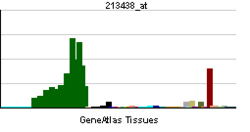NFASC
Neurofascin is a protein that in humans is encoded by the NFASC gene.[1][2][3]
Function
Neurofascin is an L1 family immunoglobulin cell adhesion molecule (see L1CAM) involved in axon subcellular targeting and synapse formation during neural development.[3][4]
References
- ↑ Volkmer H, Hassel B, Wolff JM, Frank R, Rathjen FG (Jul 1992). "Structure of the axonal surface recognition molecule neurofascin and its relationship to a neural subgroup of the immunoglobulin superfamily". J Cell Biol 118 (1): 149–61. doi:10.1083/jcb.118.1.149. PMC 2289533. PMID 1377696.
- ↑ Burmeister M, Ren Q, Makris GJ, Samson D, Bennett V (Oct 1996). "Genes for the neuronal immunoglobulin domain cell adhesion molecules neurofascin and Nr-CAM map to mouse chromosomes 1 and 12 and homologous human chromosomes". Mamm Genome 7 (7): 558–9. doi:10.1007/s003359900168. PMID 8672144.
- ↑ 3.0 3.1 "Entrez Gene: NFASC neurofascin homolog (chicken)".
- ↑ Ango F, di Cristo G, Higashiyama H, Bennett V, Wu P, Huang ZJ (October 2004). "Ankyrin-based subcellular gradient of neurofascin, an immunoglobulin family protein, directs GABAergic innervation at purkinje axon initial segment". Cell 119 (2): 257–72. doi:10.1016/j.cell.2004.10.004. PMID 15479642.
Further reading
- Hortsch M (1996). "The L1 family of neural cell adhesion molecules: old proteins performing new tricks.". Neuron 17 (4): 587–93. doi:10.1016/S0896-6273(00)80192-0. PMID 8893017.
- Nakajima D, Okazaki N, Yamakawa H et al. (2003). "Construction of expression-ready cDNA clones for KIAA genes: manual curation of 330 KIAA cDNA clones.". DNA Res. 9 (3): 99–106. doi:10.1093/dnares/9.3.99. PMID 12168954.
- Tuvia S, Garver TD, Bennett V (1998). "The phosphorylation state of the FIGQY tyrosine of neurofascin determines ankyrin-binding activity and patterns of cell segregation.". Proc. Natl. Acad. Sci. U.S.A. 94 (24): 12957–62. doi:10.1073/pnas.94.24.12957. PMC 24245. PMID 9371782.
- Ren Q, Bennett V (1998). "Palmitoylation of neurofascin at a site in the membrane-spanning domain highly conserved among the L1 family of cell adhesion molecules.". J. Neurochem. 70 (5): 1839–49. doi:10.1046/j.1471-4159.1998.70051839.x. PMID 9572267.
- Zhang X, Davis JQ, Carpenter S, Bennett V (1998). "Structural requirements for association of neurofascin with ankyrin.". J. Biol. Chem. 273 (46): 30785–94. doi:10.1074/jbc.273.46.30785. PMID 9804856.
- Nagase T, Ishikawa K, Suyama M et al. (1999). "Prediction of the coding sequences of unidentified human genes. XI. The complete sequences of 100 new cDNA clones from brain which code for large proteins in vitro.". DNA Res. 5 (5): 277–86. doi:10.1093/dnares/5.5.277. PMID 9872452.
- Koroll M, Rathjen FG, Volkmer H (2001). "The neural cell recognition molecule neurofascin interacts with syntenin-1 but not with syntenin-2, both of which reveal self-associating activity.". J. Biol. Chem. 276 (14): 10646–54. doi:10.1074/jbc.M010647200. PMID 11152476.
- Ratcliffe CF, Westenbroek RE, Curtis R, Catterall WA (2001). "Sodium channel beta1 and beta3 subunits associate with neurofascin through their extracellular immunoglobulin-like domain.". J. Cell Biol. 154 (2): 427–34. doi:10.1083/jcb.200102086. PMC 2150779. PMID 11470829.
- Jenkins SM, Kizhatil K, Kramarcy NR et al. (2002). "FIGQY phosphorylation defines discrete populations of L1 cell adhesion molecules at sites of cell-cell contact and in migrating neurons.". J. Cell. Sci. 114 (Pt 21): 3823–35. PMID 11719549.
- Jenkins SM, Bennett V (2002). "Ankyrin-G coordinates assembly of the spectrin-based membrane skeleton, voltage-gated sodium channels, and L1 CAMs at Purkinje neuron initial segments.". J. Cell Biol. 155 (5): 739–46. doi:10.1083/jcb.200109026. PMC 2150881. PMID 11724816.
- Charles P, Tait S, Faivre-Sarrailh C et al. (2002). "Neurofascin is a glial receptor for the paranodin/Caspr-contactin axonal complex at the axoglial junction.". Curr. Biol. 12 (3): 217–20. doi:10.1016/S0960-9822(01)00680-7. PMID 11839274.
- Kizhatil K, Wu YX, Sen A, Bennett V (2002). "A new activity of doublecortin in recognition of the phospho-FIGQY tyrosine in the cytoplasmic domain of neurofascin.". J. Neurosci. 22 (18): 7948–58. PMID 12223548.
- Strausberg RL, Feingold EA, Grouse LH et al. (2003). "Generation and initial analysis of more than 15,000 full-length human and mouse cDNA sequences.". Proc. Natl. Acad. Sci. U.S.A. 99 (26): 16899–903. doi:10.1073/pnas.242603899. PMC 139241. PMID 12477932.
- Gollan L, Salomon D, Salzer JL, Peles E (2004). "Caspr regulates the processing of contactin and inhibits its binding to neurofascin.". J. Cell Biol. 163 (6): 1213–8. doi:10.1083/jcb.200309147. PMC 2173730. PMID 14676309.
- Ota T, Suzuki Y, Nishikawa T et al. (2004). "Complete sequencing and characterization of 21,243 full-length human cDNAs.". Nat. Genet. 36 (1): 40–5. doi:10.1038/ng1285. PMID 14702039.

